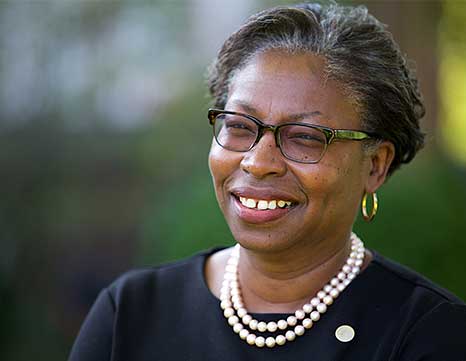Ralph Ellison’s Invisible Man took center stage at the inauguration of our new president on Saturday. Given that Tuajuanda Jordan is a scientist, I was delighted to hear her quoting from the novel’s famous prologue to illustrate her vision for the college.
First, however, I owe a note of explanation to longtime readers of this blog. Four years ago I was reporting on the inaugural speech of our last president, Joe Urgo. I went on to write several posts about President Urgo’s speeches as he was an eloquent defender of the liberals arts and, as a William Faulkner and Willa Cather scholar, generally found a way to get one of both of those writers into his talks. Unfortunately, President Urgo was less successful as a president and made some bad personnel decisions, which alienated the community and, more critically, undermined our admissions efforts. He was therefore asked to resign.
Tuajuanda is the first African American president in the history of St. Mary’s College of Maryland. This fact had all the speakers, including Minority Whip Steny Hoyer, digging into Maryland’s racial past. Indeed, there seemed to be as much talk about Maryland’s colonial and slave history—the college is located in St. Mary’s City, where British Catholics settled in 1634—as there was about the future. Professor Jordan herself made references to a local slave market and to Maryland’s two most famous slaves, Frederick Douglass and Harriet Tubman.
The theme of President Jordan’s talk was “making the invisible visible,” so it makes sense that she would turn to the theme of invisibility in Ellison’s book. She opened with one of my favorite passages from the famous prologue:
Once I saw a prizefighter boxing a yokel. The fighter was swift and amazingly scientific. His body was one violent flow of rapid rhythmic action. He hit the yokel a hundred times while the yokel held up his arms in stunned surprise. But suddenly the yokel, rolling about in the gale of boxing gloves, struck one blow and knocked science, speed and footwork as cold as a well-digger’s posterior. The smart money hit the canvas. The long shot got the nod. The yokel had simply stepped inside of his opponent’s sense of time.
What does this have to do with invisibility? The explanation is intricate and ultimately very exciting. The unnamed narrator of Ellison’s novel is invisible because whites refuse to see him. While racism is awful, however, it also can be turned to one’s advantage. Here’s the narrator again:
Invisibility, let me explain, gives one a slightly different sense of time, you’re never quite on the beat. Sometimes you’re ahead and sometimes behind. Instead of the swift and imperceptible flowing of time, you are aware of its nodes, those points where time stands still or from which it leaps ahead. And you slip into the breaks and look around.
Now to our college. When Tuajuanda talked about making the invisible visible, she wasn’t only thinking about herself as one who once would have been invisible. The unique mission of St. Mary’s is to provide a small liberal arts college experience to those who are relatively invisible, students of color and with lower incomes. Tuajuanda wants to increase our efforts to bring such students to St. Mary’s.
And there’s another invisibility that concerns Tuajuanda. St. Mary’s is frequently described as Maryland’s “hidden gem,” and Tuajuanda is determined that we not remain hidden. Part of the problem is that small state colleges are not taken as seriously as top notch private liberal arts colleges, perhaps because we are strapped for resources and can’t offer as many amenities. Our alumni have less money than those from many private institutions, making fund raising a notable challenge. But whatever the reasons for our invisibility, Tuajuanda has visibility in her sights.
Back to the Ellison passage. If, as a state college, we are taking a pummeling in the boxing ring of higher education, we need someone who can step through conventional wisdom and prove the smart money wrong. Tuajuanda already has a track record of thinking outside the box (or seeing through the nodes of time). When she was the director of the Science Education Alliance of the Howard Hughes Medical Institute, she initiated programs to get undergraduates involved in original scientific research. It’s a model that many undergraduate programs now use. So if anyone can do it, she can.
One other thought. Tuajuanda’s Ph.D is in biochemistry, which leads me to think that this sentence from The Invisible Man may have special meaning to her:
Nor is my invisibility exactly a matter of a bio-chemical accident to my epidermis. That invisibility to which I refer occurs because of a peculiar disposition of the eyes of those with whom I come in contact. A matter of the construction of their inner eyes.
President Jordan is out to change this peculiar disposition of the eyes. Pray that she succeeds.


